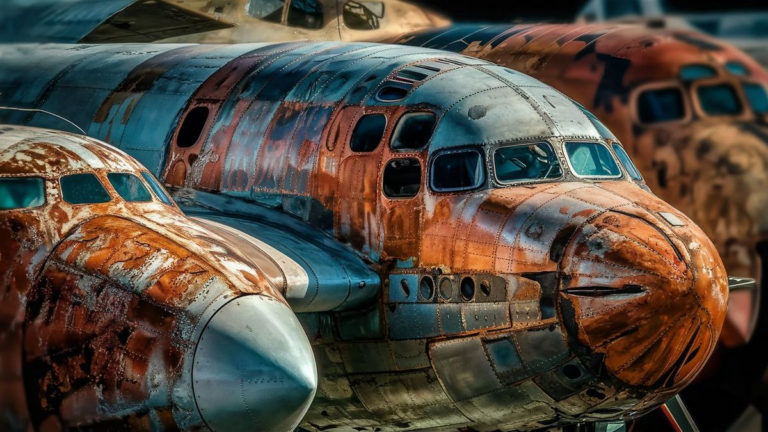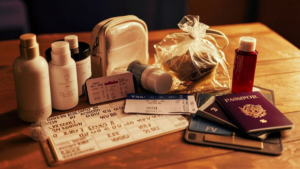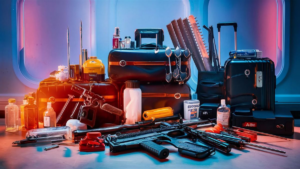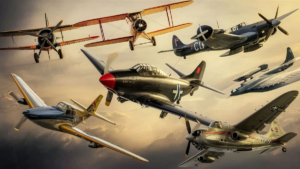Corrosion is a significant concern in the aviation industry, posing challenges to the structural integrity and safety of aircraft. Understanding the various types of corrosion that can affect aircraft is crucial for effective maintenance and ensuring the longevity of these complex machines.
Uniform Corrosion
Uniform corrosion is the most common form of corrosion encountered in aircraft. It occurs evenly across the surface of a metal, gradually weakening the affected area. This type of corrosion is often a result of exposure to environmental elements such as moisture, salt, and pollutants, making routine inspections and protective coatings essential.
Galvanic Corrosion
Galvanic corrosion arises when dissimilar metals come into contact in the presence of an electrolyte, leading to a flow of electric current between them. In aircraft, where various metals are used in construction, such as aluminum, steel, and titanium, galvanic corrosion can occur if not properly managed through design considerations and the use of protective measures.
Pitting Corrosion
Pitting corrosion is characterized by the formation of small pits or craters on the metal surface. It is often initiated by localized damage, such as scratches or nicks, providing a breeding ground for corrosion to start. Regular inspections and addressing surface imperfections promptly are essential to prevent the progression of pitting corrosion.
Crevice Corrosion
Crevice corrosion occurs in confined spaces where moisture and other corrosive agents accumulate, such as joints, seams, or fastener locations. Aircraft, with its intricate structure and numerous joints, is susceptible to crevice corrosion. Thorough inspections and corrosion prevention strategies are crucial to mitigating this type of corrosion.
Stress Corrosion Cracking
Stress corrosion cracking is a more severe form of corrosion that results from the combined effects of stress and corrosive environments. Aircraft components experiencing both tensile stress and exposure to corrosive elements are at risk. Rigorous stress analysis, corrosion-resistant materials, and routine inspections are essential for preventing stress corrosion cracking.
Intergranular Corrosion
Intergranular corrosion affects the grain boundaries of a metal, weakening the structure along these boundaries. This type of corrosion is often associated with specific alloys and improper heat treatments during manufacturing. Careful material selection and adherence to proper manufacturing processes are critical in preventing intergranular corrosion in aircraft.
Environmental Cracking
Environmental cracking includes various forms of corrosion-induced cracking, such as hydrogen-induced cracking and corrosion fatigue. These types of cracks can compromise the structural integrity of aircraft components. Regular inspections, material testing, and preventive measures are imperative to minimize the risks associated with environmental cracking.
In summary, the aviation industry faces the constant challenge of combating corrosion to ensure the safety and longevity of aircraft. By understanding the various types of corrosion, implementing preventive measures, and conducting routine inspections, we can effectively manage and mitigate the impact of corrosion on aircraft components.
Frequently Asked Questions about Aircraft Corrosion
Q1: How often should aircraft undergo corrosion inspections?
Regular inspections are crucial in detecting and addressing corrosion in aircraft. The frequency depends on factors such as usage, environmental conditions, and the aircraft’s age. Generally, industry standards recommend inspections at least annually, with more frequent checks in corrosive environments.
Q2: Are there specific coatings to prevent uniform corrosion?
Yes, protective coatings play a vital role in preventing uniform corrosion. Specialized paints and sealants designed for aviation applications provide a barrier against environmental elements. These coatings should be applied and inspected regularly to ensure their effectiveness.
Q3: How can galvanic corrosion be mitigated in aircraft construction?
Design considerations are essential in managing galvanic corrosion. Using compatible metals, insulating dissimilar metals, and employing sacrificial anodes are common strategies. Regular monitoring and preventive maintenance are necessary to control the impact of galvanic corrosion in aircraft.
| Corrosion Type | Preventive Measures |
|---|---|
| Pitting Corrosion | Address surface imperfections promptly, conduct regular inspections, and apply protective coatings. |
| Crevice Corrosion | Thorough inspections of joints and seams, strategic design to minimize confined spaces, and corrosion prevention strategies. |
| Stress Corrosion Cracking | Rigorous stress analysis, use of corrosion-resistant materials, and routine inspections to identify potential stress points. |
| Intergranular Corrosion | Careful material selection and adherence to proper manufacturing processes to prevent weakening along grain boundaries. |
Q4: Can environmental cracking be completely eliminated?
While complete elimination is challenging, the risks associated with environmental cracking can be significantly reduced through a combination of regular inspections, advanced material testing, and adherence to preventive measures. Continuous research and technological advancements also contribute to improving corrosion resistance.
Q5: What role does material selection play in combating corrosion?
Material selection is paramount in preventing corrosion. Choosing corrosion-resistant alloys, proper heat treatments, and understanding the environmental conditions the aircraft will face are essential. Collaborative efforts between materials engineers and aviation manufacturers are crucial in enhancing the longevity of aircraft components.
See also:






